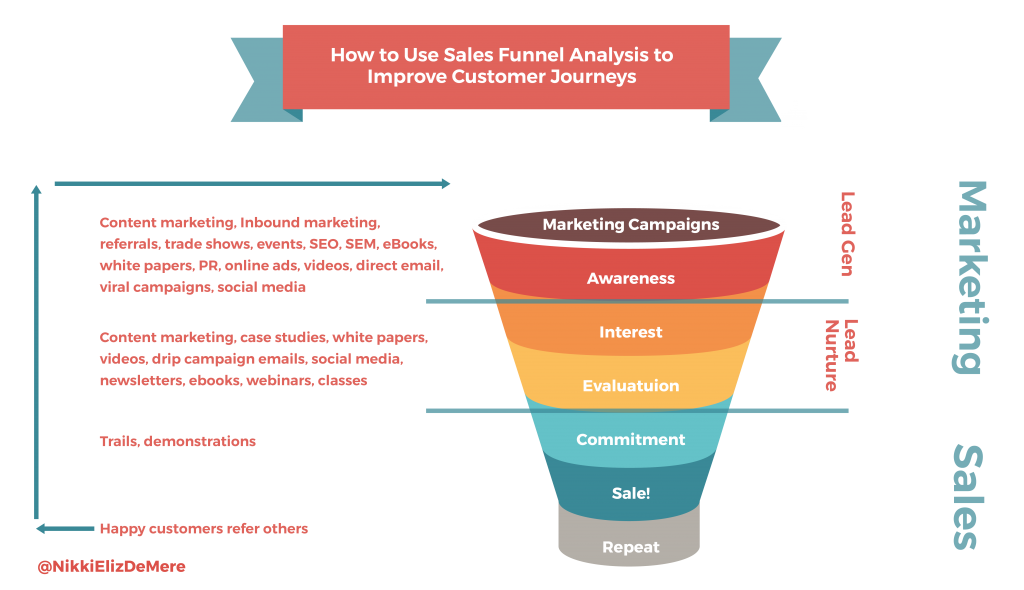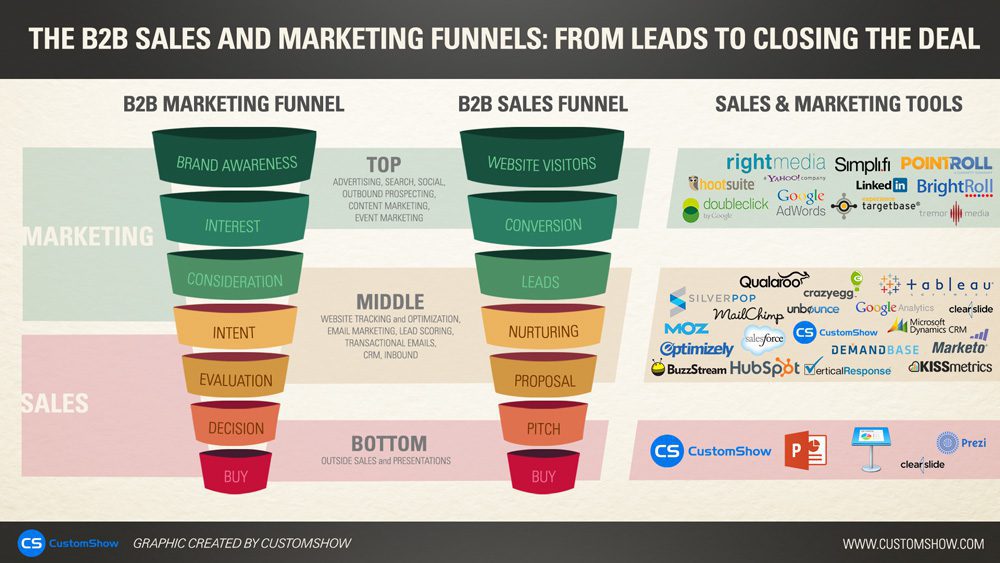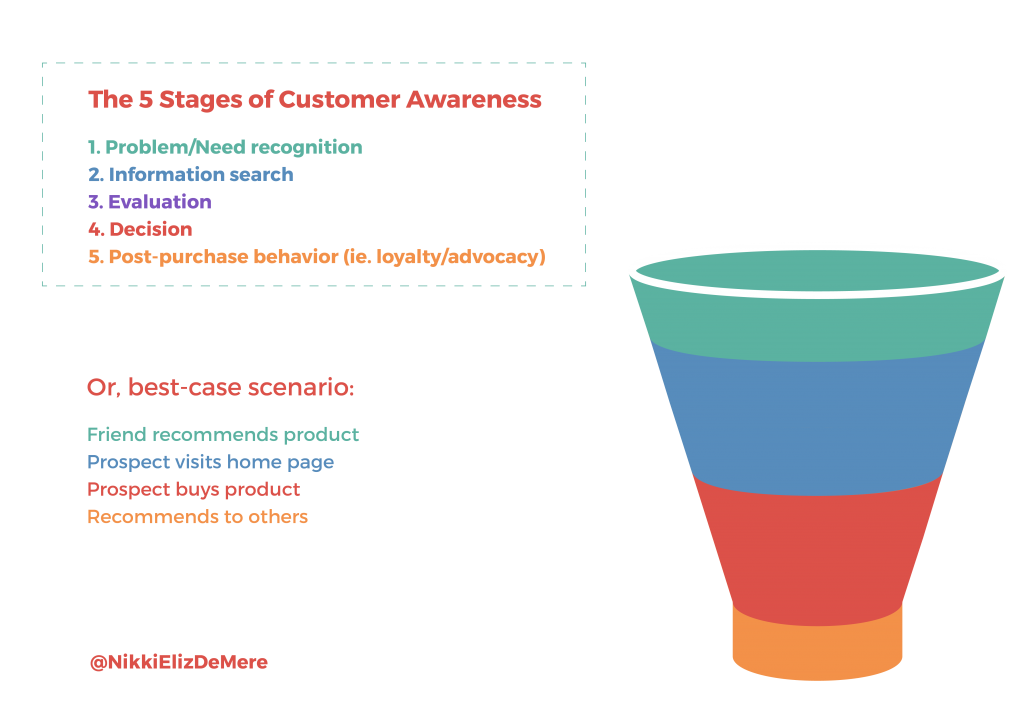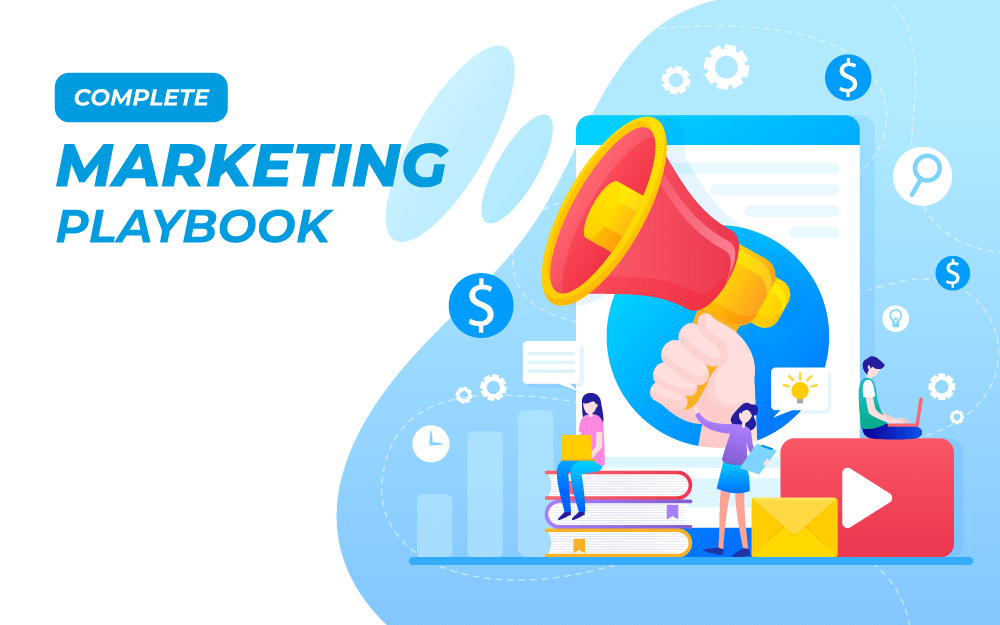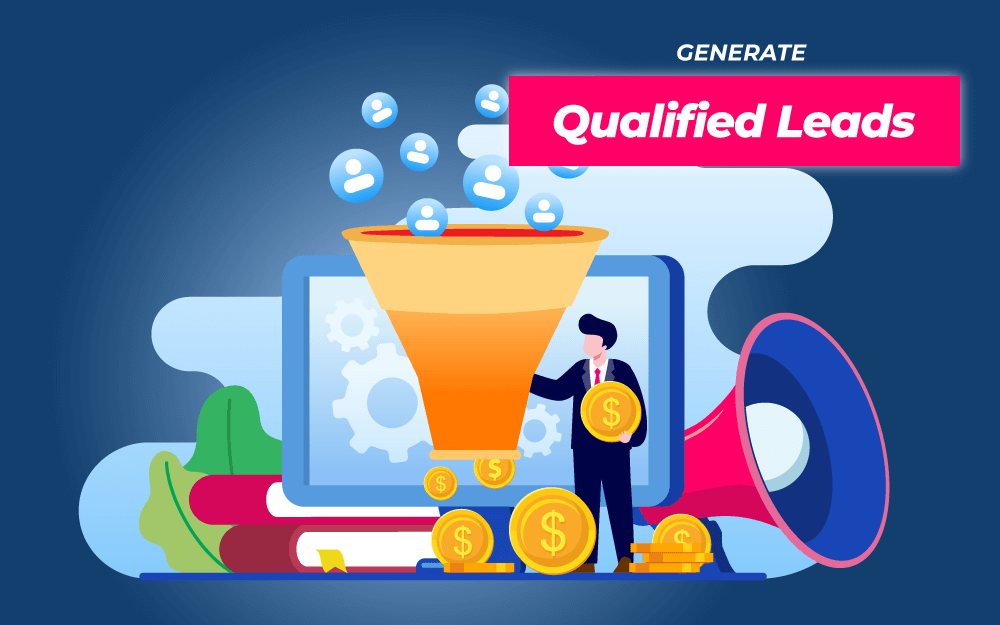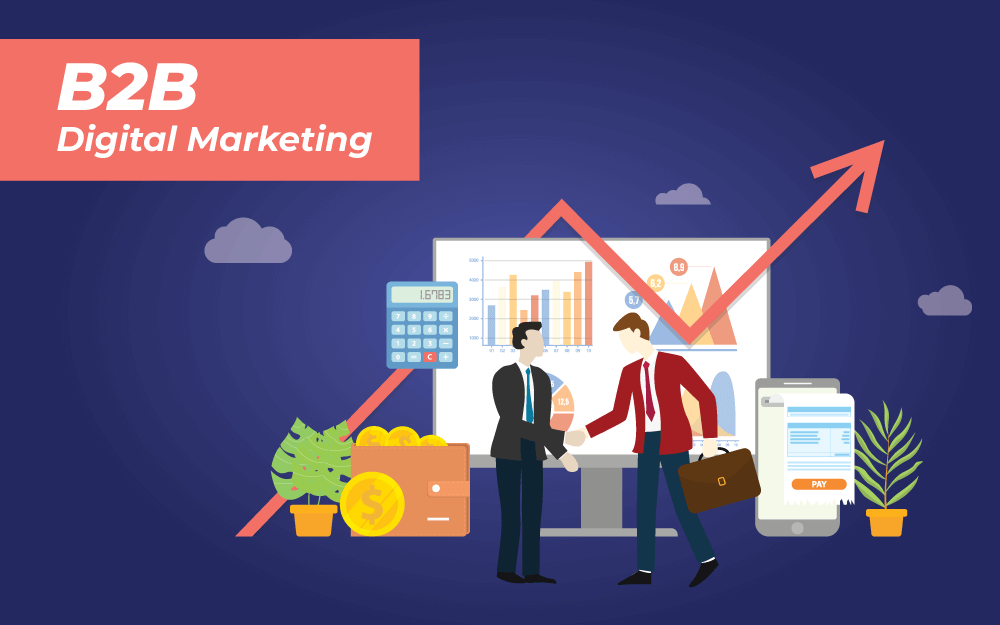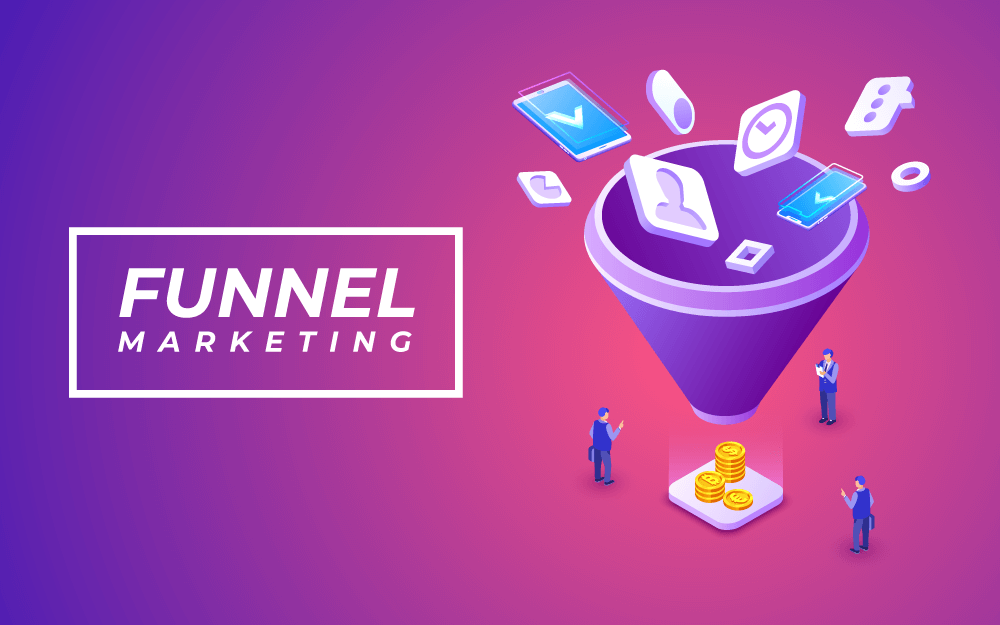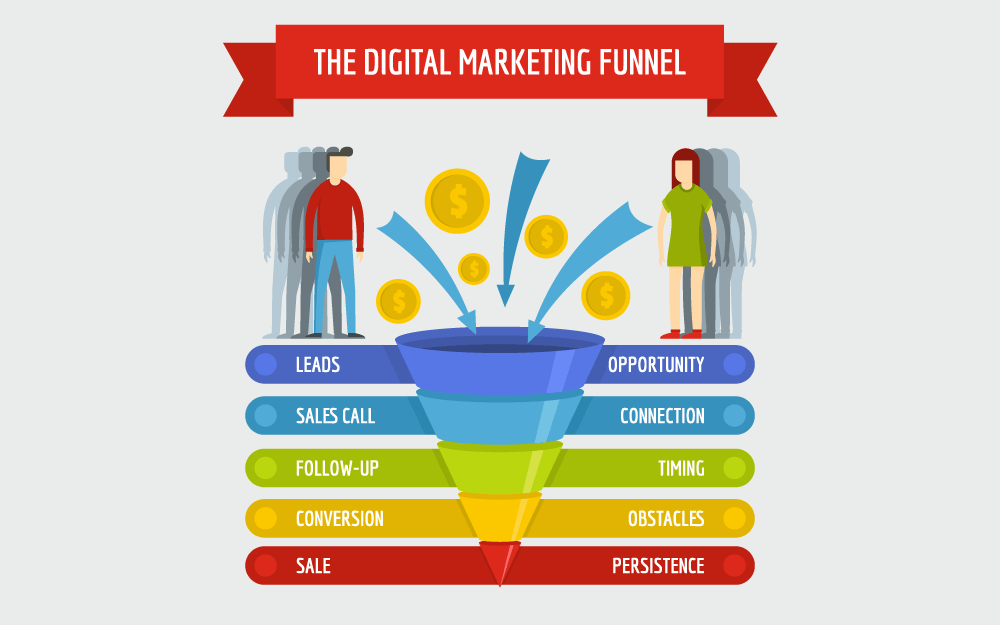
Start customer relationships.
Nurture relationships.
Deepen them.
Convert.
The ‘funnel’ metaphor is so neat, so tidy—and so misleading. Break down the customer journey from awareness through interest, evaluation and conversion stages and you will discover it has flaws. I like to argue that the first step in sales funnel analysis is to analyze the funnel structure itself, because—it doesn’t always work perfectly.
The content of this article is originally published on Funnel Analysis: How to Turn Your Sales Funnel into a Customer Success Sieve by Nichole Elizabeth DeMere
Let’s take a good hard look at our assumptions regarding the typical Sales Funnel:
The typical sales funnel, depicted above, should represent what customers see, read and experience as they journey through stages of awareness, learning more about their problems and possible solutions as they do so.
The funnel image is also about volume. You have a lot of prospective customers at the top, but comparatively few make it all the way down.
Have you ever used an actual physical funnel? If you have, what is going through your head right now?
That’s not how a funnel works.
We’ve all swallowed this idea of a sales funnel, but a funnel is what you use to pour a large amount of something into a smaller container without spilling any of it all over the counter. The idea is that all the particles make it through.
A sales funnel would work like this if you could, and did, convert absolutely everyone who might potentially be a lead. Then a funnel would make sense, but your business would be in trouble because…
What you actually need is a strainer, filter or a sieve.
How a Marketing Sieve Works:
A marketing sieve makes much more sense than a funnel. My chosen metaphor is the ‘sales sieve,’ because you don’t want every prospect to purchase.
Some prospects are not qualified to buy your product or service; they’re not good fits. They don’t have what it takes to succeed. They don’t have the exact problem your product will solve, or they don’t have the funds or decision-maker buy-in to purchase.
They will never be happy. Even if you sell to them they will drive your customer service reps batty with questions and complaints. They will push up your cost-to-acquire and leave you bad reviews.
Nobody needs that.
As marketers, we often think it’s our job to get as many people through to sales as possible. It isn’t. Our job is to get the right people through, warmed up and ready to buy. This approach replaces lead generation with qualified lead generation.
Who are the right people?
Your ideal customers are the ones who have what it takes to successfully use and absolutely love your product. When we approach ‘funnel analysis’ it’s with this in mind. We’re not plugging holes in a leaky vessel. We’re making sure the right-fit customers get through, while the bad-fit customers don’t.
It’s an entirely different paradigm.
Let’s get one FAQ out of the way before we dive in: When should you analyze your sales funnel? Answer: You should never STOP.
The 5 Stages of Customer Awareness.
Like how that last one bypasses several steps? That’s our end-goal. We want to structure our sieve or filter to create a higher likelihood of word-of-mouth recommendations, lowering cost-to-acquire and raising retention rates. We can do that by taking a good hard look at the first two models.
Remember: question all assumptions.
Assumption #1: The customer already knows they have a problem
We’re going to assume the customer knows that he or she has a problem and a pain point. But, when we’re creating our awareness-stage content, we are NOT going to assume that the customer has identified the problem or pain point.
The customer may need further education, and this is where you can begin to separate the right-fit customers from the bad-fit customers by using your awareness-stage content strategy.
As you educate your ideal customers on the problems they’re having, you’re also explaining your philosophy, approach, and the brand experience they can expect—all within the content. Prospects who resonate with your philosophy, approach, and brand experience will move to the next stage. Those who don’t will go elsewhere.
If your customers don’t already know their problem but are open-minded to your educational content and your brand philosophy, then you may consider utilizing the next ideas:
Stop Asking Your Customers What They Want (And Ask Them This Instead…)
You probably recognize at least one of these two famous quotes from a couple of pretty successful business leaders:
A lot of times, people don’t know what they want until you show it to them.”
– Steve Jobs
…and from a little further back:
If I had asked people what they wanted, they would have said faster horses.”
– Henry Ford
Hmm…
Great quotes, and often rolled out to counter that over-simplified “the customer is always right” argument.
But…
Don’t they sound kinda… arrogant?
(I know: heads of multi-million-dollar corporations, arrogant? Shock horror etc)
They even seem to suggest that listening to your market is a dumb idea.
On the surface, at least.
But look a little closer and you’ll see it’s not quite that simple…
They actually raise a really important point about your marketing, and it’s something a lot of people miss.
Because neither quote completely refutes the importance of asking your audience for their thoughts…
They just highlight something a lot of marketers, startups and service providers screw up:
They’re asking the wrong questions.
Specifically, what Jobs, Ford and many other (single-syllable or otherwise) ‘gurus’ are warning you against, is the seemingly obvious practice of asking your customers what they want, in order to serve them better.
Don’t do it, they say.
But hold up…
Does that mean you should stop asking your customers what they want?
Doesn’t that go against the accepted wisdom of market research – that seemingly-essential, zillion-dollar industry that helps us understand our customers and potential customers?
Well, sorta. But not quite…
Because the real key to discovering how you can best serve your audience is NOT by asking people what they want…
It’s by asking them what they don’t want.
Here’s the key difference between the two concepts:
Asking “what do you want?” is putting the pressure of creating (or at least, describing) a solution onto the person who has the problem needing fixing.
And of course, they may not be able to fully explain this hypothetical ‘solution’, because they’ve not experienced it yet.
So you’re shooting in the dark…
It’s challenging for you as a product creator and/or marketer to ‘magic up’ something that matches the incomplete description your market research just gave you.
But asking “what do you want to avoid?” gives you something to shoot at…
A problem (or problems) to solve with your product/service, as clearly defined by the person currently experiencing that problem.
So you don’t have to go the whole Henry Ford and stop talking to your customers.
(Or, offering them any colour “as long as it’s black” either.)
Instead, ask them questions… the right questions.
Just don’t ask ’em to tell you what they want.
Here’s how you can use this ‘anti-marketing’ to help grow your biz, sell more stuff and better understand your market:
Focus on existing problems, not an imagined solution
Focusing on the problems your prospect has currently, and asking them about what they already know and understand…
…Instead of forcing them to discuss a solution they don’t yet have, can’t yet feel, or fully recognise…
Is becoming a huge part of marketing effectively in 2016 and beyond.
With an emphasis on asking your customers and prospects what their problems are before you start outlining your solution to those problems, you gain deep insights you’d otherwise miss.
It’s about removing the guesswork, assumption and speculation from your marketing.
(And you don’t need me to tell you how dangerous that particular ‘axis of evil’ can be to your biz…)
The good news is, you can do this at any stage of your business growth
So whether you’re at the product development stage, are already racking up millions in sales, or are right now realising “nuts, didn’t we just send out a survey asking our customers what they want?” – it’s not too late.
Sometimes as biz-owners or employees, we get too close to our products. It’s important not to lose outside perspective.
So, talking with your customers lets you get information directly from them.
And by asking them what they want to avoid…
What they want never to happen to them again…
What they want to eliminate from their lives as fast as possible…
That’s where the most valuable insights are.
But wait…
What about this other idea that appears to go against Jobs and Ford…
Harry Browne’s influential Mad Men-era classic “The Secret of Selling Anything” is often quoted by copywriting heavyweights like Gary Bencivenga and John Forde – and for good reason.
The book clearly and convincingly presents a no-frills, ethical “road map to success for the salesman who is not aggressive, who is not a ‘smooth talker’ and who is not an extrovert” (the book’s subtitle).
Here’s the key section:
The one rule that sums up the job to be done, the one formula that is fully in harmony with the real world, the secret of success is: Find out what people want and help them get it!
This is the way you separate yourself from the mass of people who just ‘get by.’ This is how you make sure that your services are always in demand. This is how you command a high price in the marketplace, by making sure that what you’re offering is what people really want…”
Notice, Browne doesn’t explicitly say “ask what they want…”
He says “find out what they want” – which doesn’t necessarily mean asking “what do you want?” directly.
Because there are other, more effective questions for uncovering the information you need.
(And finding out what your audience doesn’t want is just the beginning…)
So how do you put the right questions together in the right order, and get the kind of responses you need to move forward?
The answer’s pretty simple, really.
The simple, un-sexy as hell, but proven way of asking the questions that unlock your market…
It’s a ‘Shiny Object Syndrome’-proof tactic you can use constantly and implement fairly easily.
What is this incredible weapon of marketing wizardry?
The good ol’-fashioned survey.
Pretty boring, huh? Yup! : )
But done right, sending a survey is one of the most powerful and cost-effective ways of improving your marketing.
Now, I said “sending” a survey, but of course you don’t always have to send it.
In digital marketing, getting people to come to your surveys – and actually enjoy filling them out while they’re there – is where the big wins are to be had.
Sure, a lot of companies use surveys… you see them all the time, and you’ve probably filled a few out yourself.
But here’s the thing: most are doing them wrong.
They’re crippling their own business by asking the wrong questions, gathering the wrong information, or misinterpreting that info and heading down a blind alley.
But what if…
What if YOU knew how to ask your audience all the right questions…
So you could uncover a treasure trove of insights – not just ‘data’ (‘big’ or otherwise) – that allowed you to target sections of your market with pinpoint accuracy…
And what if you could tailor your products AND your marketing to the people who actually enjoy giving the answers to those key questions…
…without making the expensive screw-ups your competition – and countless other businesses – are making right now, and will continue to make?
From corporate behemoths to boxfresh startups and kitchen-table entrepreneurs, the no-longer-so-humble survey is a great way for anyone to understand their market better than ever before.
That’s great—we want that.
So, what happens when you’re not doing awareness-stage content well?
Either you’re turning off everybody, or you’re turning off right-fit customers. Is this happening to you?
Assumption #2: Your content is attracting the right people and doesn’t suck
I wish it wasn’t so easy for businesses and marketers to assume their content is ‘good enough.’ Consider how much lackluster content there is out there…it’s a prevalent problem. Not only is it a problem for prospects searching for answers, it’s a problem for the businesses providing incomplete, uninspired, or uninteresting answers too. Informative content works in top-of-funnel lead generation when it delivers value to ideal customers, and creates a positive experience.
Funnel Analysis Time: Awareness-Stage Content
To see if your awareness-stage content is effectively attracting your ideal customers, check Google Analytics to find out:
- Where are visitors to your website coming from? This may tell you where they were when they saw your ad, or what keywords they used to find you – both are hints as to what stage of awareness they’re actually in and what they need from you right now. If, for example, a lot of prospects come to your site from a Quora response, check whether they are in the evaluation stage, or the awareness stage.
- Where are they landing—on your home page? A landing page? A blog post? Which one? You may need to adjust what content you put on those pages, maybe add a freebie opt-in form to a popular post to capture more email addresses.
- What happens when they get there?
- How much time are they spending on that page? Are they reading it, or bouncing out? If they’re reading it, that’s a good sign. If they’re bouncing, you need to find out if they’re NOT your ideal customer, or if they are.
- Are they clicking around to other pages? Which ones? Are they finding what they’re searching for, or bouncing out?
To answer these questions, nothing beats a quick exit survey that triggers when they try to leave a page. Ask questions such as: ‘Did you find what you were looking for?’ Or, even better, an open-ended question such as: ‘Help us improve our content! What were you hoping to find here that you didn’t?’ The answers will tell you if they’re your ideal customers and what you may want to add to your content to improve.
Need some top-of-the-funnel content inspiration? These seven content-marketing tactics have proven very effective.
Assumption 3: Your Opt-in is Converting as it Should
For many, if not most, online businesses, the first micro-goal is to capture email addresses. This allows more opportunity for relationship-building via email campaigns and offers. To get these email addresses, you have to offer something of value—some sort of freebie that people want.
There are soooo many ways this can go wrong.
Funnel Analysis Time: Information search stage
Wrong way #1: Your freebie over-promises and under-delivers
I can’t tell you how many times I’ve seen this happen. It happens all the time. You have a freebie offer with a tempting title that promises huge value, which means you get ALL the email addresses. But, if your freebie doesn’t deliver on the value promised, it undermines trust with your target audience and they won’t buy. How do you know if your freebie is terrible?
- Prospects don’t convert into customers, or even click back onto your website, after reading the freebie.
- Prospects ‘unsubscribe’ from your emails.
Those are ‘passive’ metrics to watch for. But a sure way to see if your freebie offer is delivering value and building a relationship—instead of undermining it—is to build in a survey that asks them if they found the information they needed, and if there’s information they expected to get, but didn’t find. Revise your freebie accordingly.
Wrong way #2: Your freebie brings everybody to the yard
If your freebie is so generally appealing that ‘anyone’ would want to download it, you’ll collect a lot of email addresses, but a large number of these won’t qualify as prospects. You’ll know this is your problem if:
- Your open and read-through rates are sky-high, but your conversions aren’t.
- Your survey comes back glowing, but still no conversions.You might need to reconsider your freebie offer and create a new one tailored to your ideal client’s needs. Then, the interested prospects essentially qualify themselves by signing up. Your sign-up numbers will drop, but your conversions should rise or stay the same. Either way, the lead quality will be better.
Wrong way #3: Your freebie rocks, but still yields few conversions
Let’s say you hired a crack-copywriter to create your freebie, it’s tailored to your ideal customer like a Savile Row suit, your surveys come back with top marks, and people are clicking the CTA button to go back to your website.
And then… nothing. They’re not converting.
This happened with one of my clients. After reviewing the open rates and read-through times, I discovered that the content wasn’t the problem; the sales page was the problem!
Assumption #4: Your Sales Page Follows Best Practices—So it Should Work!
There are many wonderfully effective formulas for writing sales pages that sell. I love the AIDA framework: Attention, Interest, Desire, Action. Depending on the complexity and expense of the product, you may need to add social proof in the form of testimonials, user cases or user reviews, maybe an FAQ section, and almost certainly a guarantee.
What if your sales page isn’t selling, despite following the established best practices?
Funnel Analysis Time: Evaluation / Decision stage
You know if your sales page isn’t selling, but you may not know why—or where it’s turning people off. For landing page optimization analysis, it helps to use a tool such as Hotjar that offers heatmaps, visitor-session recordings and even conversion funnel reporting to pinpoint where prospects are getting derailed.
Here’s what to look for:
Heatmaps: Where are people looking, or at least hovering their mouse? Seeing where they’re spending more time indicates that they’re more interested in that section of the page, they’re confused by that section of the page, or you’ve got something distracting them from where they should look.
Heatmaps can also indicate what prospects think are the most compelling parts of your copy and you may find you need to move this up to the top of the page where all prospects will be sure to see it.
Session recordings: These recordings track where your visitors are going, what they’re reading, what they’re skimming or ignoring, and where they’re getting confused. It’s like looking over someone’s shoulder as they go through the website. These are useful for finding places in your sales funnel that are confusing, asking for too much too soon, or not delivering useful information.
Conversion funnel report: This is such a cool feature, because you can see which pages are effectively converting, and where people are getting lost or turned off. If you notice that a page isn’t performing the way it should, try triggering a survey to pop up as visitors leave the page to ask them what they were hoping to find, or if a task was difficult (i.e. a customer effort score survey).
Assumption #5: Quiet Customers are Happy Customers
What’s happening after customers purchase? They go through onboarding, hopefully make it to using the product, and then recommend it to everyone they know – right? Well, we hope so. But analyzing this very important stage of the funnel will let us know for sure.
Funnel Analysis: Post-purchase Behavior
The onboarding process is where many customers drop out, not completing onboarding, or if they do, not using the product past the first couple of tries. Many businesses assume that if customers aren’t asking for help, or aren’t canceling their subscription, they’re happy.
That’s not the right metric. What we need to ask—and check for—is whether they’re successful.
Why is customer success more important than customer happiness? Because customers who use your product to reach their real-world goals are much more likely to become customer advocates, recommending your product to their friends and colleagues.
There are a couple of primary ways to measure and check customer success during the post-purchase phase.
Onboarding
Your onboarding process makes or breaks retention rates, so it’s really important to know exactly how many customers are making it through, and where you’re losing people. It may help to trigger strategically placed in-app (or on-page) Customer Effort Score (CES) surveys when ‘red-flag’ behaviors occur, such as spending too long on one page, failure to complete a part before exiting out, etc.
CES surveys tell you why people are having trouble, but you’ll also want a fix in place to help customers in the moment. Consider ending the survey with: ‘Would you like a Live Chat representative to help you out?’ Or provide a similar offer of help ASAP.
Pay special attention to places in your onboarding process where customers can expect their first small wins – those first few successes that make them feel like they’re on the right track to the big wins they’re hoping to get by using your product.
This is the Time-to-Value (TTV) metric, or Time-to-First Value, a SaaS metric that measures how much time customers have to spend on your product to feel like they’ve made progress with their goals. The lower the TTV, the higher retention rates get. In fact, some experts argue (and I agree) that the goal of onboarding is to get the customer to experience that first value, as quickly as possible!
Net Promoter Score
Once the customer has experienced value – and every time your customer experiences a win with your product – it’s a great time to send a Net Promoter Score (NPS) survey. NPS surveys ask: ‘On a scale of one to ten, how likely are you to recommend this product to a friend?`
Asking this question tells you if they are, in fact, finding value when and where you expect them to. If they are, it’s a good time to ask promoters (anyone who scores a nine or ten) if they’d be willing to share their success on a social media platform – and be sure to furnish them with a convenient link to Twitter, Facebook or LinkedIn, etc.
Funnel Analysis or Sales Sieve? The Process is the Same
Whether you’re fixing the funnel you have or optimizing your funnel into a sieve that collects only the likeliest prospects, the principles are the same. You’re always going to look at customer behavior and compare it with what you expected of it.
When there’s a mismatch between your expectations and their real-world actions, it’s time to ask why? Then question your assumptions and test your hypotheses with customer research and well-placed surveys.
Ultimately, no marketing strategy or sales formula takes the place of asking your customers and prospects what they need, what they expect, and what they actually found. Don’t forget to also ask what they don’t want.
If you want help with filling your sales funnel with ideal customer candidates, contact Harold@IdealSalesLead.com or 318-349-4998

